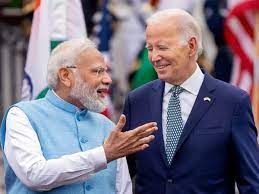Opinion | It’s Time for India to Take a Different Aim at Minority Welfare
A major proclamation about the rights of people who are members of national, ethnic, religious, or linguistic minorities was endorsed by the UN on December 18, 1992. As per Article 1 of this statement, every state has the obligation to ensure the protection of minorities’ national or ethnic identity, culture, religion, and language within its borders. States are also urged to provide favorable circumstances for the development of minority identities. It was highly recommended that nations create their own laws to deal with this issue. This incident took place in the midst of the Gulf Wars, which led to several wars throughout the globe and the collapse of the Soviet Union and Yugoslavia.

The only international document that expressly addresses minority rights is the non-binding United Nations Declaration on the Rights of Persons Belonging to National or Ethnic, Religious, and Linguistic Minorities (UNDM). Nonetheless, there are internationally enforceable laws, such as Article 5 of the UNESCO Convention against Discrimination in Education, Article 30 of the Convention on the Rights of the Child, and Article 27 of the International Covenant on Civil and Political Rights, which safeguard the rights of minorities. India earnestly attempts to safeguard its minority populations and abides rigorously by all applicable laws. The National Commission of Minorities, which was founded in 1993 by India in accordance with the UN declaration, acknowledges six groups as minority communities in India: Muslims, Christians, Jains, Sikhs, Buddhists, and Parsis.
Prior to the creation of these organizations, minority rights had always been respected in our country. When the Parsi community suffered persecution in several parts of West Asia, we gave them a place to live. In the same way, amid the Jewish community’s suffering in Europe, we welcomed them as our own. We have always supported this cause since we were the first colony to guarantee the preservation of minority rights after attaining independence.
Certain Western organizations unfairly try to discredit our record on minority rights, despite our steadfast dedication to it. The Economic Advisory Council to the Prime Minister (EAC-PM) recently released a paper titled “Share of Religious Minorities: A Cross-Country Analysis,” which emphasizes the benefits of our ongoing efforts to empower the minority population. But this research also makes us consider if, when creating government welfare programs, it is important to subcategorize minorities or to concentrate on marginalized minorities.
The EAC-PM study states that there was a 43.15 percent growth in the percentage of Muslims in the population, from 9.84 percent in 1950 to 14.09 percent in 2015. The percentage of Christians increased by 5.38 percent between 1950 and 2015, from 2.24 to 2.36 percent. The percentage of Sikhs also increased, rising from 1.24 percent in 1950 to 1.85 percent in 2015—a 6.58 percent increase. Furthermore, the percentage of Buddhists in the population increased significantly, from 0.05 percent in 1950 to 0.81 percent.
Nonetheless, the proportion of Jain people in India fell from 0.45% in 1950 to 0.3% in 2015. The proportion of the Parsi population in India fell precipitously by 85%, from 0.03 percent in 1950 to 0.004 percent in 2015.
The research notes that the population of almost all minority populations is increasing, although the Muslim community is primarily responsible for this growth. Given this, it is imperative that the state distribute funds wisely in order to foster an environment that is friendly to members of other minority populations as well. There is already increasing dissatisfaction among Christians in regions like Kerala since most social programs intended for underrepresented groups favor the Muslim community. The uneven allocation of welfare programs and benefits has the potential to create a gap that might compromise the social cohesion of our nation.
Some governments have increased public financing for Islamic educational institutions, while other minority faiths get very little assistance. In several states, teaching Arabic is given priority above teaching Latin, Pali, or even Sanskrit. In order to preserve social balance, chances for the growth of minority groups as a whole should be given, but there should also be a specific focus on attending to the needs of smaller minorities within these communities. Alongside these religious minorities, emphasis should also be placed on the growth of linguistic minorities.
The demographic loss of the dominant group is the second issue that requires attention. The same data states that between 1950 and 2015, India’s Hindu population fell by 7.82 percent, from 84.68 percent to 78.06 percent. The majority community finds this trend concerning, and it calls into doubt the meaning of secularism as set out in our Constitution. It will take time to ascertain if our Constitution’s secularism tenets need to be redefined. Our demographic pyramid’s structure will change if the majority population keeps becoming smaller.
A decline in the dominant religion’s adherents has historically had a considerable impact on the economy and population. Consequently, there is reason for concern based on these statistical statistics. Such a change has the potential to cause major budgetary imbalances and social conflicts in a nation with a high rate of population expansion.
According to UN estimates, India will overtake China as the world’s most populous country in April 2023. However, the precise numbers will remain unclear until the next census is completed. Additionally, India will have a greater minority population by then—possibly surpassing the combined population of many nations. Natural resource availability and use will be under strain as a result.
As a result, we need to reevaluate our definition of minority status in light of geographical classification and population growth. To maintain our economic pace, population expansion requires a reallocation of resources and a reevaluation of our objectives. We can only really advocate for the rights of minorities by taking such proactive steps.
Implementing stringent steps to solve the issues brought on by population expansion would be something to think about. Strict border restrictions and a strong immigration policy are required to limit immigration from surrounding nations, particularly those with a dismal history of protecting minorities. It’s time to give linguistic minorities a formal designation and include them in the larger category of minorities. Communities that have consistently improved their socioeconomic indices after gaining independence could be removed from the list to make room for more marginalized communities. In effect, this would increase the number of minorities in India.
However, in order to bring about meaningful change, there must be enough legislative backing in addition to changes at the policy level. This will make it possible for us to realize the promise of our demographic dividend in our quest to become the third-largest economy in the world.







